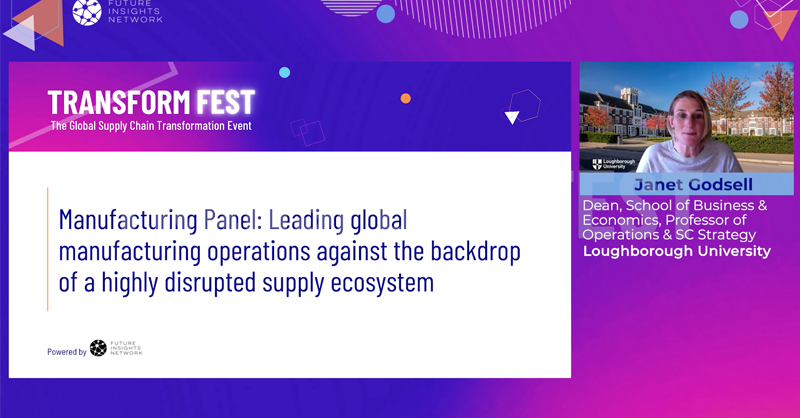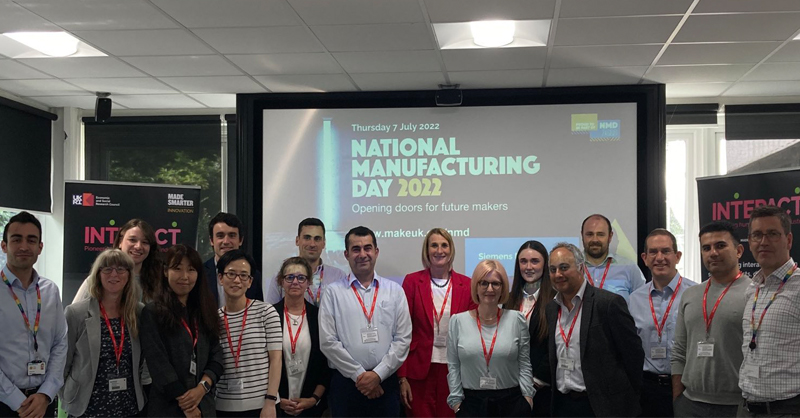InterAct Co-Director and Dean of Loughborough University’s School of Business and Economics, Professor Janet Godsell, hosts a panel discussion on ‘Leading global manufacturing operations against the backdrop of a highly disrupted supply ecosystem’.
Hear from InterAct Co-director, Professor Jillian MacBryde, as she answers some of the frequently asked questions around our Early Career Researcher (ECR) Fellowship.
Refer to our funding opportunities webpage to find out when the ECR Fellowship application windows are open.
UK manufacturing supply chains have been tested to their limits by the global disruptions of recent years, from Brexit to COVID 19 and the crisis in Ukraine.
To regain competitiveness during this turbulent time, firms are urged to take stock of their supply chains and consider:
• What could the future of UK manufacturing look like? • What are the associated business models?
• How can they leverage industrial digital technologies to create a more sustainable, responsible future?
This webinar examined the results of a survey of manufacturing firms in the Midlands region and launching the ‘Future of Digital Manufacturing Ecosystems’ project. This is a joint programme between the InterAct Network led by Professor Jan Godsell (Dean of the School of Business and Economics, Loughborough University), Make UK and Midlands Engine.
This session, led by InterAct Co-director Professor Jan Godsell and featuring successful InterAct grant applicant Dr. Andreas Schroeder examines examples of successful applications, developing opportunities for networking/feedback, and through sharing our knowledge of navigating the administrative processes associated with funding calls.
Find out more about how you can develop better funding proposals and more effectively tie your research in to the overall aims and objectives of InterAct and Made Smarter Innovation.
Open Funding Call – Q&A Webinar
Hear from InterAct Co-directors, Professors Jan Godsell and Jillian MacBryde, as they discuss the specifics InterAct Open Funding Call and answer numerous questions pertaining to the call.
The InterAct Open Funding Call is a single Commissioned Research call with a budget of £400,000. There will be up to eight awards, with no minimum value for a request, but the maximum that shall be awarded to any single project is £62,500 (at 100% FEC), of which 80% will be funded by InterAct (i.e., £50,000 maximum funding for a single project).
Projects are welcomed from a broad range of economic and social sciences, that will create ‘actionable insights’ to support the delivery of the five Made Smarter Innovation challenge objectives.
Full details of the funding call are available on our funding opportunities page.
Open Funding Call – Launch Webinar
Hear from the InterAct Network team as they discuss the specifics InterAct Open Funding Call in this launch webinar.
The InterAct Open Funding Call is a single Commissioned Research call with a budget of £400,000. There will be up to eight awards, with no minimum value for a request, but the maximum that shall be awarded to any single project is £62,500 (at 100% FEC), of which 80% will be funded by InterAct (i.e., £50,000 maximum funding for a single project).
Projects are welcomed from a broad range of economic and social sciences, that will create ‘actionable insights’ to support the delivery of the five Made Smarter Innovation challenge objectives.
Full details of the funding call are available on our funding opportunities page.
The InterAct team, in collaboration with Make UK and Midlands Engine, recently launched a joint research programme – ‘Digital Future of Manufacturing Ecosystems’. The project aims to identify the ‘Vision 2040’ for the UK manufacturing industry and develop digital roadmaps to support the transition.
Our partners Make UK are spearheading the effort to broaden the appeal of manufacturing careers and build excitement around the industry. On Thursday, 7th July, they held National Manufacturing Day 2022. This annual celebration is a day for companies to open their doors and generate national recognition of the manufacturing sector.
InterAct, as a Made Smarter Innovation funded network, joined this effort with our first Discovery Day event, focused on the ‘Digital Future of Manufacturing Ecosystems’.
We welcomed guests from across the academic, manufacturing and digital technology sectors to join us at Siemens‘ factory in Congleton, Cheshire. Attendees had the opportunity to take part in a guided tour of key workstations within the factory environment and hear from Siemens staff about the benefits of Knowledge Transfer Partnerships in a business environment.
InterAct Co-director and Principal Investigator of the Digital Future of Manufacturing Ecosystems, Professor Jan Godsell further elaborated on the innovative work of her team in regards to supply chains and digitalisation in the manufacturing environment.
Participants were then encouraged to discuss the importance of incorporating new research in industry, developing new ideas and building mutually beneficial relationships.
Professor Godsell said: “I’m pleased to have welcomed such an engaging and varied audience for our first Discovery Day. It’s fantastic to see how much the InterAct community has grown in the months since the programme’s foundation.
“I’d like to thank Siemens for their kind offer to host this event at their premises, where we’ve been able to showcase the practical benefits to businesses of engaging with researchers to help develop their future plans.
“We hope to carry forward this positive momentum into the coming months and years, working closely with our partners at MakeUK and Midlands Engine to shape the future of manufacturing ecosystems. I’m looking forward to welcoming many more new faces at our next events and I hope our community will continue to engage with the programme.”
If you have extensive experience in manufacturing operations, supply chain management, circular economy, sustainability, or industrial digital technology and would like to contribute to the work of the ‘Digital Future of Manufacturing Ecosystems’ team, then consider taking part in our expert interviews.
Contact Frances Zhang: w.zhang4@lboro.ac.uk to find out more about participating.
Dr. Robert Stewart (University of Strathclyde)
A host of publications in the grey and academic literatures herald the emergence of smart manufacturing and the digital transformations brought on by new waves of technological innovation. In manufacturing the Fourth Industrial Revolution (or 4IR) is the overarching socio-technical term, sometimes used to describe the changes arising from these emerging digital technologies and practices.
Smart manufacturing combines the automation of tasks, the digitisation of processes and co-ordinating platforms of digital networks alongside technologies like artificial intelligence (AI). Like the previous three Industrial Revolutions that used steam to mechanise production, electricity to power mass production, and electronic advances in information technology to automate production, smart manufacturing represents a systematic step change. This is because of the scale and complexity of integrating various advanced digital technologies (ADTs) and digitised data in manufacturing production and distribution systems.
Some of the most cited technologies include the Internet of Things (IoT), cyber-physical systems, big data analytics, cloud (and quantum) computing, additive manufacturing, 3-D printing, advanced robotics, augmented reality and blockchain technology: a landscape that is emerging and evolving through innovation, synergy and combination.
For manufacturers there are strong digitalisation incentives: longer product lifecycles, increased operational visibility, reduced costs, optimised production cycles and direct relationships with consumers. Digital servitization is the process of providing bundles of products, services and tools (e.g. big data) for greater customer value. Fuelled by cloud computing, IoT allows the multiple interconnections of (unique) ADTs, while sensors and rendering devices provide a digital intelligence to generate real-time data and actions. These along with big data analytics and platforming enable a shift to Business-to-Customer (B2C) models: greater market reach, faster product to market cycles, more brand control, opportunities to give added-value digital intelligence to products and the collection of customer usage data to inform design and product improvements interfaced with e-commerce platforming.
Digitalisation is depicted as an (yet) uncharted blue-sky horizon of technological development whose haze blurs the lines between the physical, digital and biological worlds: a fusion of technologies that will shape manufacturing sectors, workforces, jobs (their content, design, regulation and protection) and business models in the coming years. For manufacturers, the future script is one of opportunity and uncertainty: continuing and rapid product innovation as companies vie to integrate and develop their digital toy boxes of tools, products and markets.
Smart manufacturers will have to blend ADTs with the digital skills and unique attributes of people to lever their productivity gains. Typical of publications in the grey literatures, Deloitte offer an idealised vision of the types of high-skill, high-tech white-collar graduate-level jobs and roles that smart manufacturing will generate in the very near future. These stand in stark contrast to the often-stereotypical images of older, dirty, risky, and repetitive blue-collar factory jobs that can sometimes haunt images of the sector.
Deloitte outline six prototype jobs and three of these are described as examples: the Digital Twin Engineer who can ‘virtually’ look inside physical assets, systems and structures to optimise design, performance, predict maintenance and improve customer experience; the Robot Teaming Co-ordinator who trains people and bots to work collaboratively; and a popular example often cited in the literature, the Smart Factory Manager, with responsibilities for production, quality control, inventory, connectivity and analytics. Common to all these roles is the use of sophisticated co-ordinated ADT systems, AI and the support of co-bot teams working alongside people at different levels of production and distribution.
Against the backdrop of this digital toolbox meze there is no shortage of some very familiar challenges for work and employment. Automation is strongly associated with job polarisation and the decline in the share of mid-pay mid-skill jobs observed throughout leading western economies in recent decades. Digital production processes and platforming are usually negatively linked (especially in the retail and hospitality sectors) with job (and role) fragmentation and an increase in (the sometimes precarious) work that differs from the standard relationship of permanent, full-time and secure employment (i.e. ‘gig economies’).
Some of these issues may seem very distant from Deloitte’s clean, slick and precise white-collar smart manufacturing settings outlined above, in job design, smart manufacturers will still have to be savvy enough to address the issue of how to attract talent and create meaningful work: higher pay, access to employee benefits and work that is interesting. There are still several broad workforce challenges to be faced: work architecture, workforce skills and (re)training (attracting and retaining digital talent), and what this means for human resources, organisational and job/task design (and processes), strategic organisational leadership, capabilities and cultures. Working in smart manufacturing will also have the potential to raise concerns about greater data-driven employee monitoring and exposure to physical and psychosocial risks arising from constant connectivity and the overlap of work and non-work time.
A strong theme in the literature are the demands for high-skill smart manufacturing workforces with digital and ‘soft’ skills. A recent World Economic Forum study highlighted that the top 10 skills for the next decade include what we think of as essential human skills – critical thinking, creativity and people management – alongside technical digital skills. ‘Essential’ human skills are the things that cannot be automated (yet).
This skill shift puts the emphasis on retraining existing manufacturing workforces, building ‘soft’ skilled workforce capacities and more widely, being able to attract and retain ‘digital people’ talent. To support the latter, there may be markedly better opportunities created in high-tech smart manufacturing settings for equality, diversity and inclusion initiatives around working time flexibility and the labour market integration of specific groups, such as women and those with more domestic care responsibilities and health issues. Also, as products, services, workforces and supply chains become increasingly connected, this results in new chains of value creation increasing the potential for more employee-led innovations, and distributed leadership to create more opportunities for change and building capacities for improvements to products and customer services.
A major workforce challenge in transitions to smart manufacturing will be fears about job substitution and the destruction of jobs (automageddon) by the rise of the bots (and their new co-bot allies). Automation has always been the harbinger of apprehension about its consequences for jobs and aggregate levels of employment: the jobs that people can do, the tasks they will perform and the new key skills that workers will have to acquire. This is a popular image of automation even though technology also creates many new jobs.
Historically, labour markets have always accommodated and absorbed automation. Technology complements workers skills and increases their task performance, while eliminating those manual and repetitive tasks that are easier to automate. Although technology has historically had little adverse impact on aggregate employment, this still masks some underlying processes of job destruction and creation in particular sectors and groups of workers. Initially, automation complemented low-skill work. Later, it substituted for it while complementing middle and high-skill work. Today it complements high-skill work but often substitutes for middle-skill work. It is reasonable to expect that these technology-related effects in smart manufacturing will rhythmically evolve, emerge and once again change in the future.
A significant limitation of current debates in automation and smart manufacturing is that it is very difficult to predict future levels of employment given the relative recency and quality of existing studies that are trying to map events that are still emerging in ‘real time’. There is still a great deal of speculation and uncertainty about what will happen as smart manufacturing sectors emerge, grow and develop. The Babbage Repot makes it clear that smart manufacturing is largely concentrated in larger sized companies in ten developed economies who tend to be those who make the greater share of new technology patents, investments, adoptions and implementations.
Equally important but relatively understudied, are questions about how smart manufacturers influence the design of work and jobs, and which tasks/skills can be substituted, complemented or augmented. The mechanisms by which smart manufacturing technology complements/ arguments jobs and tasks are not well understood, nor the strategic decisions that companies’ make around technology investments. In this sense, there are interesting issues about workforce engagement and dialogue: and how smart manufacturers anticipate, plan and strategically balance decisions about technological investment alongside workforce issues.
Professor Colin Lindsay (University of Strathclyde)
New ways of working and leading in manufacturing
Advanced technologies such as robotics and AI, and other forms of digital innovation, open up important new opportunities for the transformation of work in UK manufacturing, with potential benefits for employees in terms of job quality and wellbeing, and for businesses in terms of improvements in productivity and innovation performance.
However, there are concerns that these benefits may not be fully realised if manufacturing businesses fail to innovate their leadership and people management practices to empower people to deploy technologies in an agile and effective way. Our research for the ESRC InterAct Network is working with manufacturing businesses to explore exactly these issues; what sort of changes in work organisation, people management and leadership are required if manufacturing employees across teams are to contribute to driving innovation and productivity?
One important clue as to what’s needed in leadership development might be provided by an emerging evidence base on the impact of ‘distributed leadership’ practices.
Distributed leadership and empowering people to innovate
One potential constraint on innovation in organisations is the concentration of leadership roles and authority among a small cadre of senior managers. That’s why in a range of organisations, especially in public services such as education and healthcare, there is growing interest in the value of an alternative approach of distributed leadership: “an approach to leadership that endorses work practices that combine knowledge, abilities and skills of many individuals… creating opportunities for leadership to emerge from individuals at all grades and levels within a team or organisation”. For example, Professor Graeme Currie and colleagues have argued that effective distributed leadership has been, and will continue to be, crucial to healthcare systems’ responses to the Covid-19 crisis.
It’s interesting that much of the current research on the challenges and opportunities of distributed leadership focuses on public services and other service sectors, with somewhat less interest from those studying manufacturing innovation. This is despite the fact that some of the seminal research on distributed leadership focused on its impact in manufacturing – more than thirty years ago, David Barry’s important research on so-called ‘bossless teams’ identified both opportunities in supporting team innovation performance and challenges where team members lacked the skills and resources to lead effectively. David Teece’s seminal work on dynamic capabilities – “the firm’s ability to integrate, build and reconfigure internal and external resources to address and shape rapidly changing business environments” – is another cornerstone for our research. It is notable that Teece and colleagues also cite distributed leadership as an important practice for dynamic and agile organisations in manufacturing and other sectors.
So, what sort of practices might be required for effective distributed leadership, and what are the potential benefits and risks for manufacturers?
Scoping the potential for distributed leadership as a route to innovation
InterAct Network researchers will be working with leading manufacturers in the coming months to explore what works in effective distributed leadership. But we already have some clues from existing research. Where distributed leadership has contributed to productivity and innovation, organisations have tended to make workplace investments to: develop leadership skills and identify succession pathways; re-design job roles to enhance autonomy; and create protected time and real or virtual spaces for leaders at different levels to collaborate and share ideas. The evidence suggests that these practices might be important, but also that context is crucial. Distributed leadership needs to be calibrated carefully to reflect the needs and capabilities of each organisation.
There are also potential challenges associated with promoting distributed leadership that need to be addressed, including: the risk of a fragmentation of accountability and unclear decision-making; gaps in leadership skills and capabilities; and limits to the time and resources available to people at different levels to participate in leadership activities.
A key theme for our InterAct research in the coming months will focus on how, and how effectively, some of our most innovative manufacturers adopt more distributed models of workplace and organisational leadership; the challenges and limits to such practices; and impacts in terms of job quality and innovation performance.
If you represent a manufacturing organisation and would like to share and learn from good practice in leadership and people management for innovation, join the InterAct Network today.
If you would like to access our free research on leadership and people management for innovation in manufacturing, contact: colin.lindsay@strath.ac.uk.
The InterAct team, in collaboration with colleagues at the ESRC PrOPEL Hub, recently hosted a webinar with keynote speakers Dr Paula Apascaritei and Professor Marta Elvira of IESE Business School, Madrid. The webinar: “Navigating uncertainty: How HRM dynamic capabilities contribute to organisational well-being and performance” was chaired by Professor Colin Lindsay of Strathclyde Business School and the InterAct team.
Dynamic capabilities have been defined as a firm’s ability to integrate, build and reconfigure internal and external resources to address rapidly changing business environments. This means that dynamic and resilient organisations are defined by their capacity to sense and articulate opportunities and threats, seize opportunities, and reconfigure tangible and intangible assets to transform ways of doing business.
How can HRM contribute to dynamic capabilities? Dr Apascaritei and Professor Elvira shared their research on what ‘HRM dynamic capabilities’ might look like in innovative businesses. First, their research points to the need for an HR function that supports ‘knowledge-building’ within and across teams, for example though the creation of real and virtual spaces for employees and managers to collaborate and learn together. Second, they pointed to value of ‘socially integrative’ HR practices, noting the importance of supporting people in different roles to build relationships with colleagues, customers and partners. Lastly, Dr Apascaritei and Professor Elvira pointed to the value of HRM that supports ‘reconfiguring’ capabilities, with an emphasis on cross-skilling and flexible working practices that fit with the innovation priorities of businesses, including in digital manufacturing.
Much of this discussion chimed with ongoing research being conducted by the ‘Future of Work’ team at InterAct. We are working with manufacturing businesses to identify ‘what works’ in people management and learning to maximise the potential of employees at all levels. If you represent a manufacturing organisation interested in learning from and sharing good practice in work organisation and people management for innovation, contact Professor Colin Lindsay – colin.lindsay@strath.ac.uk – to access our free research and consultancy services.










